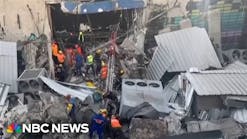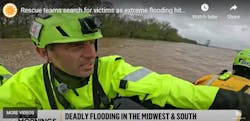Fire and EMS agencies can effectively manage one or two fatalities and do so on a regular basis due to the events that occur every day in our communities. What happens when you are faced with numerous fatalities due to a major incident?
A mass fatality incident can simply be defined as: "An incident where more deaths occur than can be handled by local resources". Some jurisdictions could easily handle five to 10 fatalities while others would be quickly overwhelmed. This article is designed to provide an awareness level of understating of mass fatality events for fire and EMS responders.
A mass fatality event can occur during several types of incidents including transportation incidents, industrial accidents, severe weather or natural disasters, fires or acts of violence. These events can be very complex and intense events that require coordination and communications from multiple agencies. The use of the Incident Management System (IMS) and Unified Command (UC) will be crucial to an effective response and recovery.
A mass fatality event needs to be regarded as different from a mass casualty incident (MCI). Also, throughout the event it is important to remember reverence for the dead and compassion for the living. These types of high-impact incidents will generate a lot of media attention. This in turn will cause many well-meaning people and family members to respond directly to the scene. It must be remembered that this type of event will emotionally charge any jurisdiction and that the public will be following the response and recovery very carefully.
Mass fatality events will put a tremendous strain on the responders and the system. These situations can create severe economic, environmental, and emotional impacts on responders and the community. In the past, public safety agencies have successfully planned and trained for mass casualty incidents. What happens when there are more fatalities than victims? Who in your jurisdiction is the lead agency in a mass fatality incident? What is the "benchmark" to declare a mass fatality incident? What then becomes the role of local responders? These are just a few items that need to be addressed in your planning.
Hazard Assessments & Pre-Planning
Your benchmark notifications should be addressed in your local guidelines and procedures. Another important pre-planning step is to decide what types of events in your community could cause a mass fatality incident. Do you have an airport? Is a there major freeway running through your jurisdiction? Is there major industry? Large scale planned events? What past events have occurred in your community: flooding, hurricanes, tornadoes, terrorism, etc.? All these issues should be addressed in a community hazard assessment.
The countywide hazard assessment should be completed by all public safety agencies. Some of the key players in planning for this type of event will include: emergency management, law enforcement, emergency medical services, medical examiners/coroners, funeral directors, fire service, hospitals, etc. As you can see this type of event will require a tremendous amount of cooperation among many disciplines.
The next step in the pre-planning phase is to identify your resources available in your community to effectively manage the event. Your local emergency management offices are a good resource to assist in this process as many OEM offices maintain an extensive "Resource Guide". How many fatalities can the local morgues handle? What is the daily caseload of the local Medical Examiner? How quickly will the hospital system be overloaded? What resources are available locally and regionally through mutual aid agreements? How can I notify these resources?
Response Operations
Your first indication of an event may come with the initial 911 calls and dispatches. Is there a high-impact plane crash with 45 "souls on board", a severe bus accident with numerous injuries, a massive tornado in a populated area or a mass shooting at a public location? These could all be triggers of a mass fatality event. During the initial "windshield survey" the incident commanders must quickly decide if the event meets the "benchmark" criteria of a mass casualty or mass fatality response.
Life safety is always critical during the response but we also must remember reverence for the dead. At some point during the "response" the proper notifications must begin to prepare a proper mass fatality response. The response phase of a critical incident could be over very quickly and the recovery phase could go on for some time. After all living victims are removed, the fire is out, rescues completed, scene is secured, etc., the scene will switch from the "response" phase to the "recovery" phase. This is the point at which the complex components of a mass fatality incident begin.
Throughout the response it is important to remember reverence for the dead and compassion for the living. There are numerous considerations in this type of event that will need to be addressed as soon as possible The deceased must be left in place until released by the medical examiner or coroners office. The event may also be a crime scene or part of a major investigation and must be treated as such at all times. Scenes are usually videotaped and photographed with bodies in place as a minimum. Many mass fatality incidents will also be involved with criminal and civil proceedings at a later date.
Bodies and body parts can be scattered everywhere. There could be numerous burned victims. Fatalities could be women, men, elderly and children and it could be a crime scene that covers several square blocks. All bodies, body parts, personal effects and other evidence will need to be documented. Responders must not touch or move these items unless advised. There is an organized process that will be used to effectively manage these types of events. The quicker the process is completed and the deceased identified, the quicker the healing process can begin for the community, families and responders. This is one of the reasons in Israel that the scenes of suicide bombings are cleared and cleaned within four to six hours.
Fire and EMS agencies will be tasked to stand by at these events. Also these agencies may be requested to assist with scene security, site surveys, body recovery and other tasks. These individuals must be asked if they can assist, not ordered. Once the deceased are recovered, the identification and processing process will begin. It is preferable for the normal morgue to be used for this process. If the numbers overwhelm local morgue capabilities then a secured temporary morgue area can be established. At this point it is highly recommended that you contact state and federal resources to assist in this event.
During a mass fatality event a large law enforcement response will be required. There will be scene issues, investigation procedures, scene security, notifications, etc. Security will be a major issue at the incident scene and at the family assistance centers (FAC), which may be opened to address the needs of the deceased friends and family members. This event will require public information officers (PIO) and most likely a joint information center (JIC) to effectively handle all media interviews and enquiries.
Safety Issues
Safety of our responders is always paramount. These events are usually always designated as biohazard areas, requiring the proper amount of personal protective equipment and safety guidelines for responders. Your planning must also take into consideration the weather/terrain and the fact that there could be spilled fuel, collapsed structures, confined spaces, building debris, glass, aircraft or vehicle parts, crime scene evidence, etc. scattered about. These issues may require additional safety procedures in place including decon for the living and dead, helmets, respiratory protection, specialized teams, etc. This is one event that you must have an established an experienced safety officer program designated in your command structure.
The Occupational Safety and Health Administration (OSHA) has also produced an OSHA Fact Sheet: "Health & Safety Recommendations for Workers Who Handle Human Remains" available at: http://www.osha.gov/OshDoc/data_Hurricane_Facts/mortuary.pdf.
Resources
During a mass fatality response, some of the numerous items you may require consist of a large supply of body bags, disposables suits/gowns, gloves, booties, refrigerated trailers, decontamination and rehabilitation tents, light trucks, generators and professional removal/transport vehicles. Also the need for a command oost, feeding services, latrines, temporary housing for responders, etc. You may be on your own for the first right to 12 hours before state and federal assets arriving on scene, except for your planned local and regional mutual aid resources.
It is important to identify your local and state medical examiners office as they will be the lead agency in the recovery operations and have an extensive amount of information and experience to help you in your planning and response. Your local emergency management office can contact these agencies 24 hours a day, seven days a week. As part of your planning process it is important to identify these key types of local and state resources that are available to assist your jurisdiction. Please check with your local emergency management office, as there may be an existing "mass fatality" annex as part of your jurisdictions "emergency operations plan" or "multi-hazard plan".
A federal resource available for assistance through the Department of Homeland Security (DHS) is the National Disaster Medical System (NDMS) Disaster Mortuary Assistance Team (DMORT). This is a Federal Level Response team designed to provide mortuary assistance in the case of a mass fatality incident or cemetery related incidents. There are several teams across the country that can be activated in case of a disaster or major event. They will work under the local jurisdictional authorities such as coroner/medical examiners, law enforcement and emergency managers. Additional information can be found at http://www.oep-ndms.dhhs.gov/.
A new field manual for first responders offers step-by-step guidance on how to recover and identify victims killed in disasters while respecting the needs and rights of survivors. The Pan American Health Organization (PAHO), the World Health Organization, the International Committee of the Red Cross, and the International Federation of Red Cross and Red Crescent Societies recently published a manual. The manual Management of Dead Bodies after Disasters: A Field Manual for First Responders can be found at www.paho.org
Among the main points emphasized in the manual are:
- The overwhelming desire of people from all religions and cultures is to identify their loved ones. Careful and ethical management of dead bodies is a critical component of disaster recovery.
- Dead bodies pose a negligible threat to public health, since most victims die from injury, drowning or fire. Responders who handle dead bodies should wear gloves and practice good basic hygiene. Wearing face-masks is not necessary for infection control purposes but may help workers feel psychologically better. Bodies present virtually no risk of epidemic diseases.
- Accurate, timely, and updated information can reduce stress on survivors, defuse rumors, and dispel misconceptions. The news media are vital channels of communication with the public, and authorities should proactively engage them.
Available Training Resources
An excellent training asset for First Responders is the Federal Emergency Management Agency (FEMA) 40-hour course titled "Mass Fatalities Incident Response Course." These courses can be scheduled with through your State Emergency Management Office. Additional information can be found at www.fema.gov.
Another resource available is the National Mass Fatalities Institute at http://www.nmfi.org/index. The Institute was founded in 2000 with a congressional grant administered through the Centers for Disease Control and Prevention. Its mission is to prepare communities for the effective management of mass fatalities events. They provide training and a tremendous amount of planning resources.
Conclusion
- Situations may arise where the need to save lives overrides respect for the dead.
- Treat the dead with dignity/respect.
- The public is watching you!
Again, please remember to follow local guidelines and procedures. This article is for informational and educational purposes only. It is impossible to cover all the issues that will need to be addressed during a mass fatality response so each community should have a plan in place to address these types of events. Hopefully you will gain some information to take back to your agency to assist with planning and training efforts. The more our public safety agencies prepare, the better they are prepared to respond to effectively manage any type of situation that might arise. The community has entrusted us with their safety...So Let's Prepare Now.
August Vernon is currently an Assistant Coordinator for the Forsyth County, NC, Office of Emergency Management. August recently returned to his position at Emergency Management after a year in Iraq as a security contractor conducting long-range convoy security operations.
Vernon has been a member of emergency management since 2000, a member of the fire service since 1990 and a fire service instructor. He also served in the U.S. Army as an NBC (Nuclear, Biological & Chemical) operations specialist. Mr. Vernon teaches courses in incident management, OPSEC for public safety, hazMat operations and terrorism/WMD response. Has also been published in several national publications and is available for questions and comments at [email protected].





